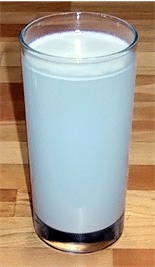The question in the title may seem trivial, as it is a question that sooner or later, almost every kid asks. However, the answer is not so straightforward and the work of several scientists was needed in order to give an adequate response. In this post, we will shed light on one of the questions that has troubled parents through generations.
The first scientist that tried to give a satisfactory explanation about the color of the sky was physicist John Tyndall. He was studying infrared radiation and he required containers filled with completely pure air. In order to check if the air was pure enough, he shone an intense light through it. In case he had not finished purifying the air, the light would scatter off of any dust motes or other remaining particles in the container [1].
He noticed that when light was scattered, it had a blue tone, while light that passed through the air without scattering had a predominantly red tone. This is called Tyndall effect or Tyndall scattering and it is defined as light scattering by particles in a colloid or in a very fine suspension [2]. Tyndall effect takes place when particles with a diameter below or near the wavelength of visible light, let’s say in a range from 40 to 900 nm, are dispersed in a light transmitting medium.

Tyndall extrapolated this phenomenon from his experiments to the atmosphere to explain why the sky is blue. Nevertheless, Tyndall’s theory had some gaps. He could not explain why blue light scattered more than red light and on the other hand, the scattering in the sky is caused by air molecules, which are much smaller than particles that are able to cause the Tyndall effect.
In 1904, John William Strutt, also known as Lord Rayleigh, studied the Tyndall effect in more depth. He observed that light perturbed the orbit of the electrons of an atom. The electrons absorbed the incident light and re-emitted it with the same frequency in a random direction, phenomenon that is called Rayleigh scattering [1]. This effect occurs with particles much smaller (around ten times) than the wavelength of radiation, that is, individuals atoms or molecules, and mostly happens with gases, although it can take place in other mediums [3].

Nevertheless, if shorter wavelengths scatter more, we could wonder why the sky is blue and not violet. The reason is that the sun is not a perfect white light source (its intensity falls in the violet) and in addition to this, the oxygen in the atmosphere absorbs wavelengths of the ultraviolet region of the spectrum [3].
On the other hand, the colors that are not scattered away (yellow, red) can be seen when directly glancing towards the sun, giving the star its characteristic yellowish tone. The reddening of the sun intensifies when it is near the horizon because the light must go through a larger proportion of the atmosphere closer to the Earth’s surface, which is denser. As a result, scattering is more important and only the longest wavelengths remain, thus making the sun look redder [3].

It has also to be mentioned that when photons are scattered, most of them are elastically scattered (Rayleigh scattering), so the scattered photons possess the same energy (same frequency, wavelength) as the incident ones but different direction. However, a small fraction of the photons scatter inelastically, which means that they have a different energy (thus higher or lower frequency) than incident photons. This phenomenon is known as Raman scattering or Raman effect [4]. The Raman spectrum of a molecule can be employed to unequivocally identify it and it is used in Surface Enhanced Raman Spectroscopy (read more about it in this article).
Returning to the colors that are present in the atmosphere, Mie scattering is worth describing. It occurs in the case of atmospheric particles whose size is similar or larger than the wavelengths of the scattered light (dust, pollen, smoke, microscopic water droplets), as opposed to Rayleigh scattering. Mie scattering tends to appear in the lower portion of the atmosphere and it is not strongly wavelength dependent. It produces the white glare around the sun when a lot of particles are present in the air and it is also responsible for the white light in the case of mist or fog [5].
As a conclusion, in this post we have explained why the sky is blue and we have learnt about some related concepts, including the Tyndall effect, Rayleigh scattering, the Raman effect or Mie scattering. However, we do not believe that this kind of explanation will satisfy a child’s curiosity.
Written by J.J. Imas
Bibliography
[1] “Why The Sky is Blue: Lord Rayleigh, Sir Raman, and Scattering.”
[2] “Tyndall effect – Wikipedia.”
[3] “Rayleigh scattering – Wikipedia.”
